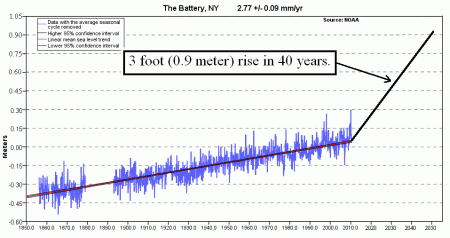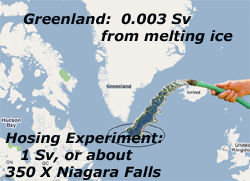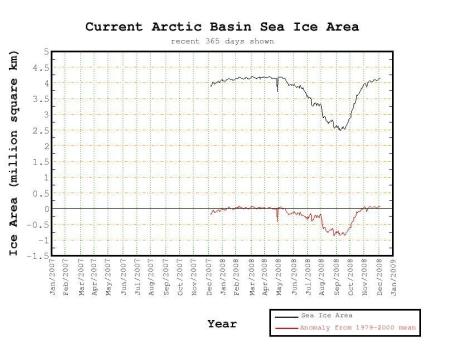Heide Cullen has written a new book expressing her views about the world’s climate 40 years from now. You may recall that Cullen is the Weather Channel climatologist who suggested that other meteorologists and climatologists who express doubts about anthropogenic global warming be decertified by the American Meteorological Society.
Her new book, “The Weather of the Future,” features an alarming computer generated image of Manhattan in a sea-level-risen, hurricane plagued world of 2050 on the front cover.
In the world of digital graphics you can create any reality you desire. In this case Cullen presents Manhattan underwater, presumably after 40 years of sea level rise combined with a category 4 hurricane storm surge.
The following picture is a close-up detail of the buildings. The group of buildings in the foreground is Lower Manhattan and the group of buildings in the background is Midtown Manhattan. “The Village” area, Chelsea, the Garment district, etc., between Lower and Midtown Manhattan is conspicuously covered in water. Water surrounds the Empire State Building, and 250 foot tall buildings immediately south of it are submerged.

The following picture is from Google Earth with a photorealistic rendering of the buildings on Manhattan as it would look today. Again, you can see the skyscrapers of Lower and Midtown Manhattan. Battery Park is the green area at the tip of Lower Manhattan. You can also see the thousands of buildings in the region between Lower and Midtown Manhattan.

What would it take to cover The Village, Chelsea and the Garment District in water?
Land on Manhattan is obviously very valuable, and the only way to expand is to go vertical. The region between Lower and Midtown Manhattan is not covered with thatched roofed tiki huts that will wash away in a hurricane. There are thousands of multi-story buildings, many of which are a hundreds of feet tall. The following Google Earth photorealistic rendering is of a typical location in the Village area (in this case near the corner of Allen St. and E. Houston St.) looking back toward Lower Manhattan. The labels show the elevations above sea level of the roofs of several buildings.
For all of these buildings to disappear below the water the combined hurricane storm surge and sea level rise would have to be over a whopping 250 feet!
Hurricanes have hit New York before and their potential effects are not a mystery. Some of them have been pretty devastating. You can see the New York and Long Island areas that would be under water today for category 1 through 4 storms hitting at high tide here. The image below shows a close up of the storm surge coverage of Manhattan with the green shaded areas covered with water for a category 4 storm. The deepest water might be about 25 feet above sea level.
Cullen’s book shows the Empire State Building on the high ground of Midtown Manhattan surrounded by water. The reality is that only the very edges of Midtown Manhattan would go under water. Much of the low-lying ground of the Village area would be underwater, but unlike Cullen’s book cover, virtually every building would still tower above the water. The streets at the base of the Empire State Building would be far above the storm surge floods.
Of course, if the sea level rises due to global warming, then the hurricane storm surge would be even worse. So, according to Cullen, how much will the sea level rise by 2050? On page 258 she says…
The new estimates for 2050, once you included all the sources of the rise in sea level – from Greenland, from Antarctica, from glaciers and ice caps, and from thermal expansion – as well as the dynamic effects, could be as high as 3 feet.
So, according to Cullen, you can add three more feet to the storm surge. That ought to cover those buildings.
How realistic is three feet of sea level rise?
But even Cullen’s 3 foot sea level rise in the next 40 years for Manhattan is rather far-fetched. There is a century and a half of sea level data for The Battery at the tip of Lower Manhattan. Take a look…
That’s it: 2.77 mm (about a tenth of an inch) per year for the last 150 years. No acceleration of the sea-level-rise-rate has accompanied increasing atmospheric CO2 levels. To get three feet in the next 40 years the sea level must rise an average of about 23 mm per year between now and 2050. That is a sea-level-rise-rate increase by a factor of nine. Something like this…

Giving credit where credit is due
Manhattan gets off more easily in Cullen’s Weather of the Future than it does in many other disaster stories. Consider The Day After Tomorrow, where Manhattan gets both flooded and frozen, or the fate of New York in Planet of the Apes. In Weather of the Future Manhattan’s problems are successfully managed by civil engineers and good planning. At least we can be grateful for that momentary break from the usual global warming narrative.





















